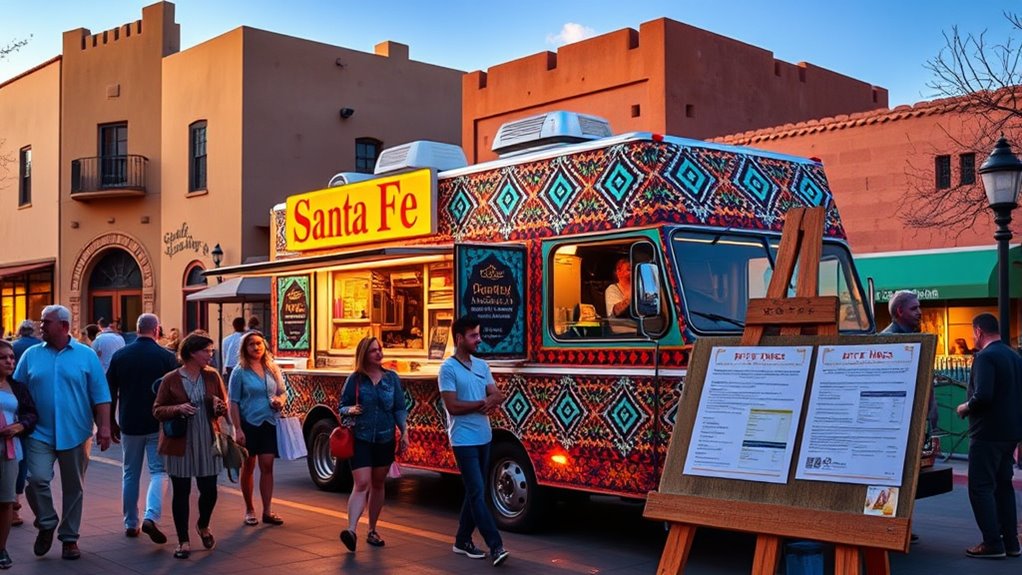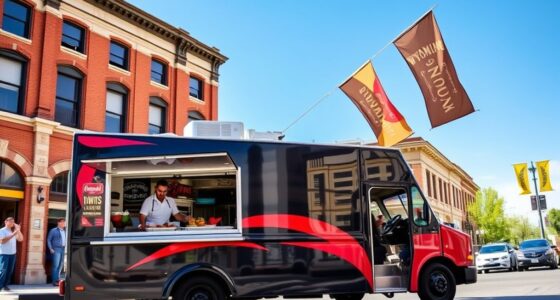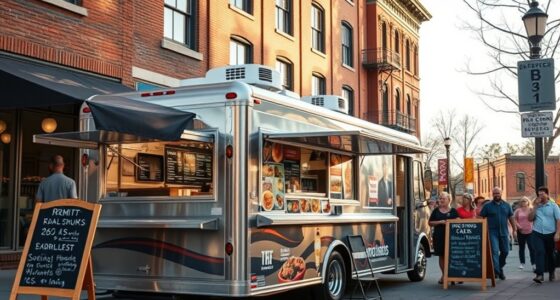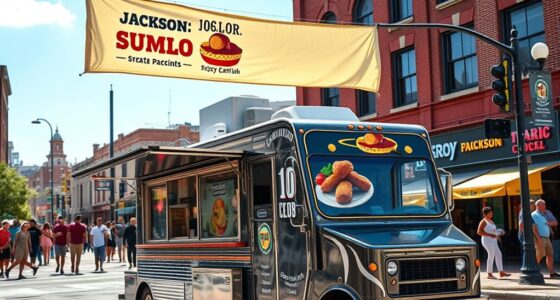To open a food truck in Santa Fe, you’ll need to secure permits like a Business License, Food Establishment Permit, and Mobile Food Unit Permit from local and state authorities, with proper display and inspections. Budget for vehicle costs, permits, insurance, and marketing, aiming for locations with high traffic and visibility. Craft a menu showcasing local flavors and follow safety standards. For more tips on staying compliant and optimizing your launch, keep exploring.
Key Takeaways
- Obtain essential permits including a Business License, Food Establishment Permit, and Mobile Food Unit Permit from local and state authorities.
- Budget $40,000-$120,000 for vehicle, outfitting, permits, insurance, and initial inventory, and plan for location fees and marketing.
- Choose high-traffic, accessible locations like Santa Fe Plaza, Midtown, or near cultural sites, utilizing GPS data for optimal placement.
- Develop a menu featuring local ingredients like green chiles and regional flavors, emphasizing food safety, freshness, and dietary trends.
- Use social media, community events, and targeted promotions to build brand awareness, engage customers, and boost repeat business.
Navigating Permit Requirements and Regulatory Standards
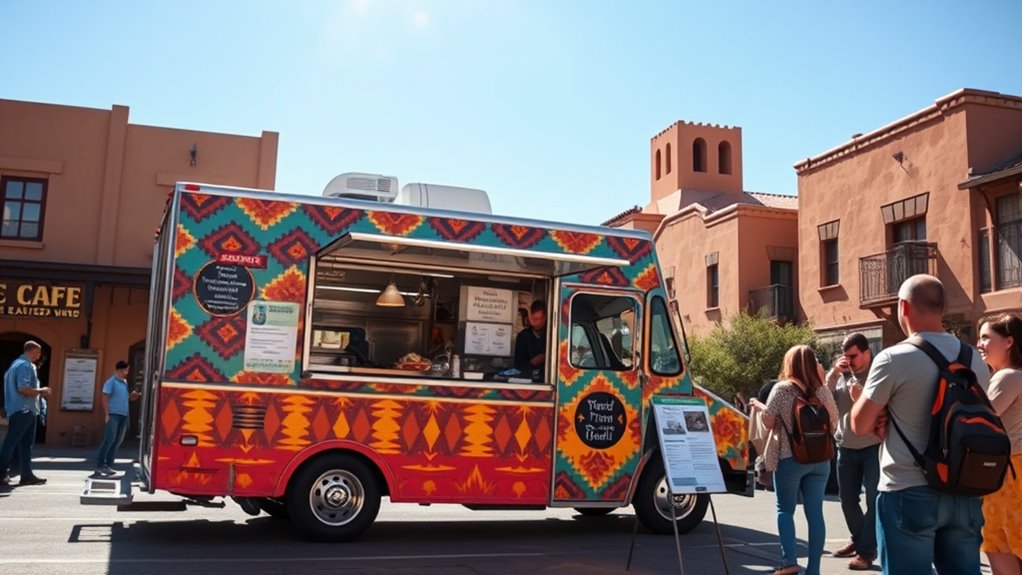
Managing permit requirements and regulatory standards is essential for legally operating your food truck in Santa Fe. You’ll need to obtain a Business License from the New Mexico Secretary of State and a Food Establishment Permit from the New Mexico Environment Department (NMED) to meet health and safety standards. Additionally, a Mobile Food Unit Permit from NMED is required, along with local permits from Santa Fe, which must be displayed on your vehicle annually. You must pass health inspections for sanitation and food safety, and fire safety checks by the fire department, ensuring proper equipment and adherence to safety codes. Vehicle registration, insurance, and proper permit display are also mandatory. Operating without these permits or safety compliance can lead to fines or shutdowns, so stay diligent. Local health departments provide detailed guidance on employee health permits and food safety regulations to ensure compliance. Ensuring your compliance procedures are up-to-date can help prevent potential legal issues and streamline your operations.
Estimating Costs for Starting Your Food Truck Business
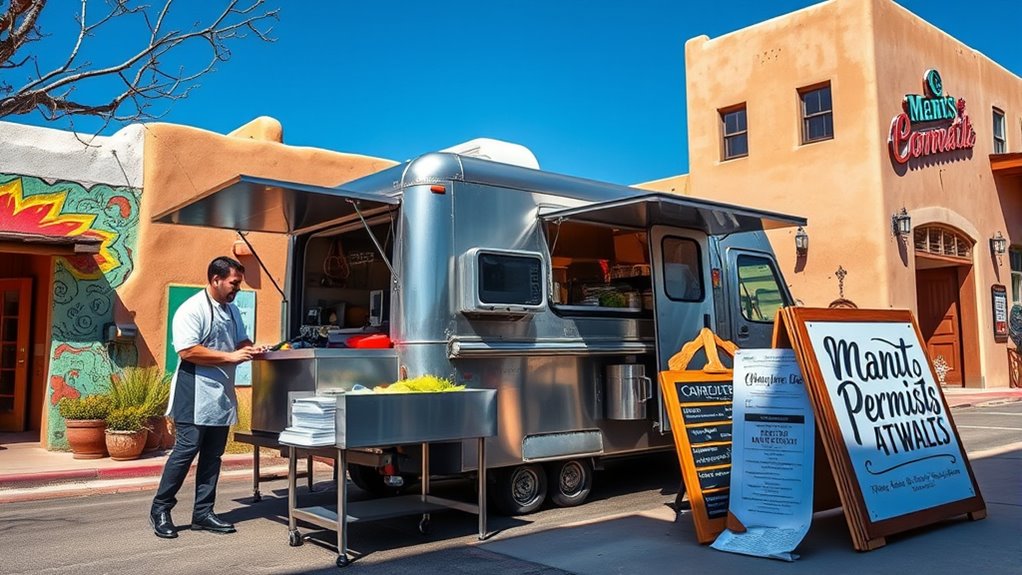
Starting a food truck business involves estimating a variety of costs that can considerably impact your budget. Vehicle costs range from about $40,000 for used trucks to over $120,000 for new, customized ones. Outfitting your kitchen, especially for New Mexican cuisine, adds to initial expenses. Used trucks lower upfront costs but may incur higher maintenance, while new trucks offer customization and reliability. Expect to spend $2,000–$3,000 on inventory and around $300 on serveware. Licensing, permits, and legal fees can vary widely, from $1,800 to $28,000, plus event permits costing $50–$200 each. Additional costs include insurance, commissary rental ($400–$1,000/month), fuel, maintenance, parking ($500–$1,000/month), tech, and marketing, totaling a significant initial investment. Understanding local regulations is crucial to ensure compliance and avoid costly fines or delays.
Identifying Prime Locations to Maximize Foot Traffic
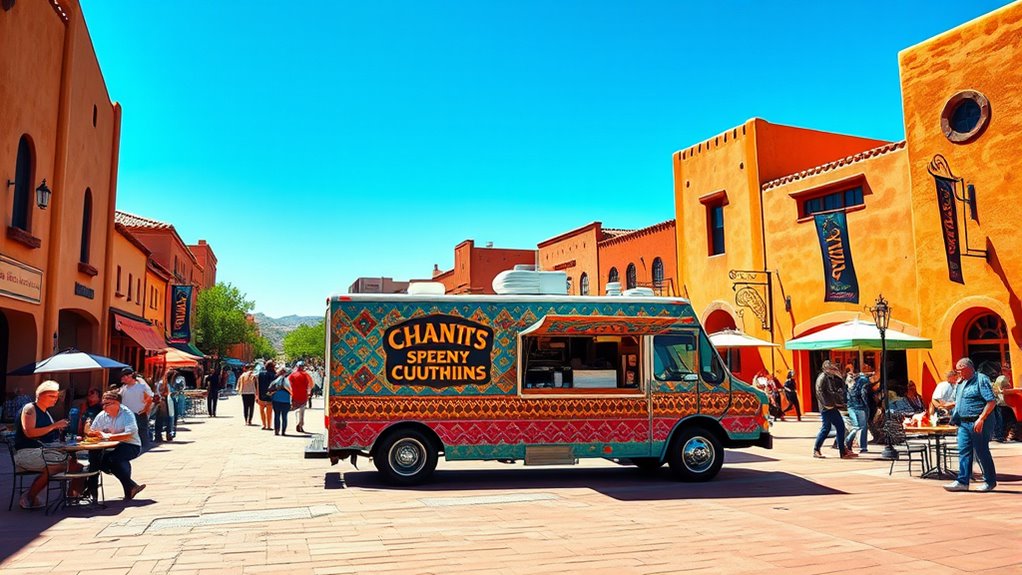
To maximize foot traffic for your Santa Fe food truck, choosing the right locations is vital. Focus on high-traffic areas like Airport Road, Cerrillos Road, and the Midtown district, where steady crowds of workers and shoppers gather. Near cultural sites such as Meow Wolf or Santa Fe Plaza, you’ll attract tourists keen for local cuisine. Parking availability and easy access are essential; sites with adjacent lots, transit stops, and pedestrian walkways boost customer flow. Consider proximity to events, art galleries, and schools, which generate consistent crowds. Additionally, understanding and leveraging email marketing strategies can help promote your location-specific offerings to nearby customers.
Designing a Menu That Appeals to Santa Fe’S Tastes and Trends
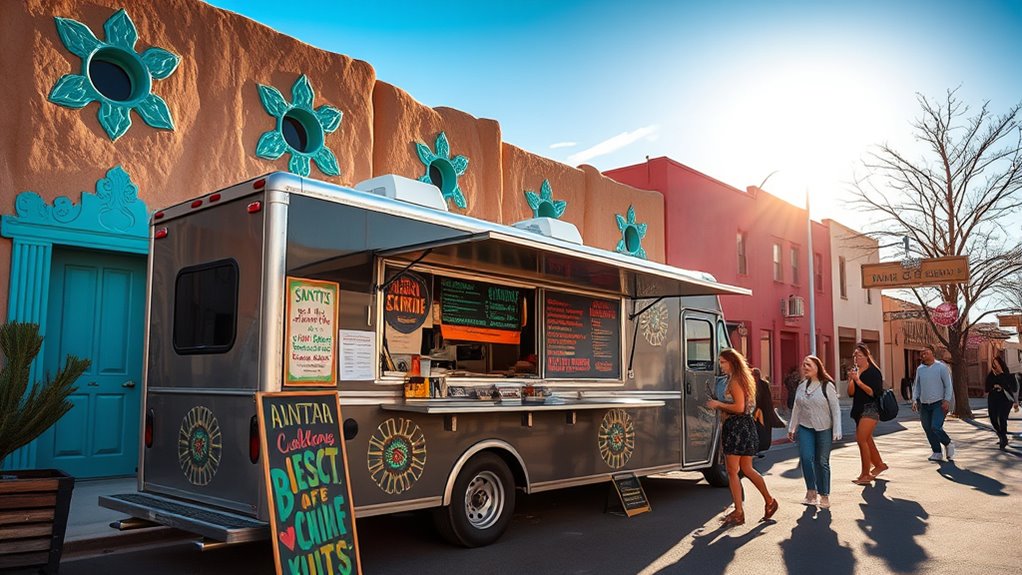
To create a menu that resonates with Santa Fe’s vibrant food scene, you need to highlight local flavors like green chiles, corn, and regional meats. It’s also essential to incorporate current dietary trends, such as healthy options and international influences, to attract diverse customers. Additionally, incorporating rustic decor elements into your restaurant can enhance the overall dining experience, creating a welcoming atmosphere that complements the local cuisine. Finally, prioritize food safety to build trust and ensure your offerings meet the community’s high standards. Restaurant Week origins demonstrate how a focus on local and diverse cuisine can successfully promote a city’s culinary scene, and applying this approach to your menu can help attract both locals and visitors alike.
Embrace Local Flavors
Designing a menu that truly resonates with Santa Fe’s vibrant culinary scene involves highlighting regional ingredients and flavors that locals and visitors cherish. Incorporate signature New Mexican staples like green and red chiles, which define Santa Fe’s spicy character, along with locally sourced blue corn used in tortillas and pozole. Feature traditional dishes such as green chile stew, breakfast burritos, and enchiladas to meet diner expectations. Embrace regional Mexican influences by adding Oaxacan mole, cochinita pibil, and street foods like tacos and ceviche, offering vibrant, fresh options. Prioritize local, sustainable sourcing by highlighting grass-fed beef, seasonal produce from nearby farmers, and wild game. This approach not only celebrates Santa Fe’s culinary heritage but also appeals to health-conscious and eco-aware customers. Supporting local farms and ranches can strengthen your community ties and ensure fresh ingredients. Additionally, emphasizing food sourcing from local suppliers aligns with the growing trend toward sustainability and transparency in dining.
Incorporate Dietary Trends
In Santa Fe’s vibrant food scene, incorporating dietary trends like plant-based, gluten-free, and allergy-friendly options can set your food truck apart. You’ll attract health-conscious locals and curious tourists by offering diverse choices. Focus on local ingredients such as blue corn, squash, and legumes to create vegan versions of regional favorites like green chile stew or jackfruit “carnitas”. Clearly label vegan and vegetarian items to build trust and transparency. Expand your reach by including gluten-free staples like hominy and native grains, and specify allergen info to reassure customers. Consider these strategies:
- Offer plant-based and vegan adaptations of local dishes
- Include gluten-free options using native ingredients
- Provide allergy-friendly menu items with clear labeling
- Incorporate superfoods and health-focused choices
- Use seasonal, local produce to ensure freshness
- Incorporate essential oils into your branding or marketing materials, such as using calming lavender scents in your stall or packaging to enhance customer experience and convey a sense of natural health.
Focus on Food Safety
Creating a menu that appeals to Santa Fe’s tastes while prioritizing food safety requires thoughtful planning. Guarantee all items meet New Mexico Environment Department standards by using ingredients that minimize contamination risk. Use locally sourced, fresh ingredients to reduce transit time and microbial growth, and choose seasonal produce for freshness and safety. Design prep areas for thorough cleaning to prevent cross-contamination, favoring simple, minimally processed foods that are easier to handle safely. Select dishes that hold up during transport, like grilled proteins or vegetable-forward options, and avoid complex assembly. Clearly label allergens, offer alternatives, and train staff on allergen protocols to protect sensitive customers. Incorporate regional flavors safely, ensuring that preparation methods and ingredients align with food safety standards while appealing to local tastes. Additionally, staying informed about modern food safety practices can help ensure that your menu remains both delicious and compliant with health regulations.
Effective Marketing Strategies to Build Your Brand
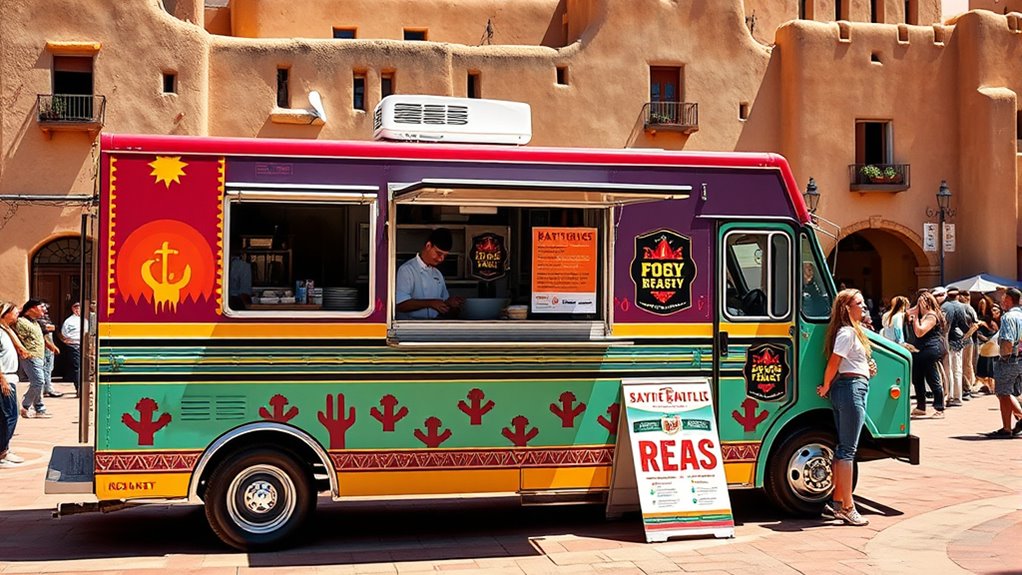
To effectively build your food truck’s brand, leveraging a mix of strategic marketing techniques is essential. Social media is a powerful tool—68% of food trucks actively use it, with 75% engaging on Facebook. Platforms like Instagram, TikTok, and Snapchat help you connect with Millennials and Gen Z, boosting sales by around 20%. You can also increase visibility by participating in local events and festivals—80% of trucks do this annually, gaining high foot traffic and reputation. Building customer loyalty through programs and email marketing keeps customers coming back and increases repeat visits by 30%. Finally, harness technology like GPS apps and data analytics to target marketing efforts, improve efficiency, and enhance customer experience. Heartfelt messages can also be used to foster positive relationships and encourage customer engagement. These strategies help solidify your brand presence in Santa Fe’s vibrant food scene.
Ensuring Compliance and Safety for Smooth Operations
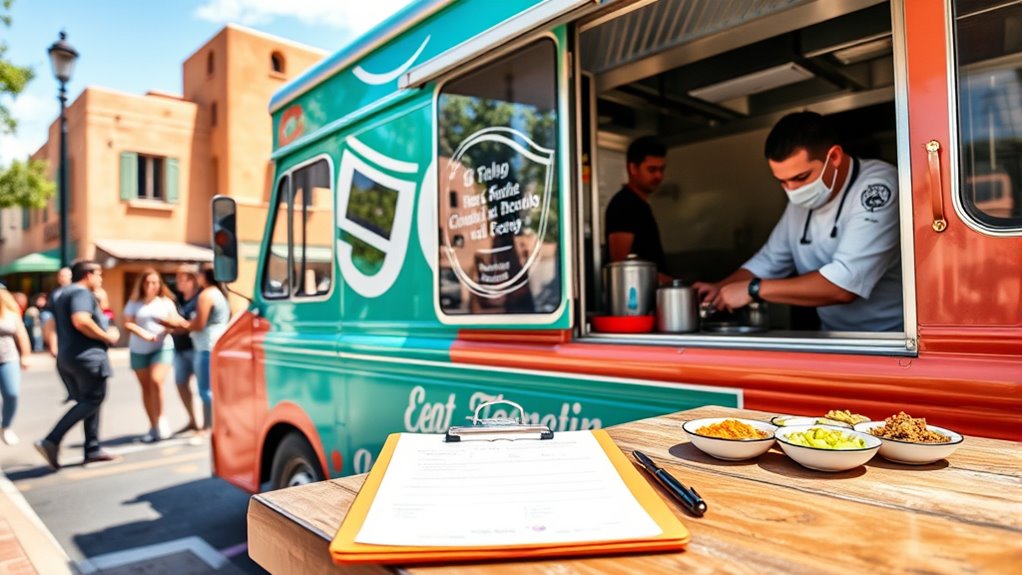
To keep your food truck running smoothly, you need to follow fire safety regulations and guarantee your equipment meets all safety standards. Regular health inspections verify that your food handling and sanitation practices stay compliant with local laws. Make sure your permits are clearly displayed to avoid fines and demonstrate your commitment to safety. Additionally, understanding essential oils for safety and health can be beneficial for maintaining a healthy work environment.
Fire Safety Regulations
Ensuring fire safety compliance is essential for smooth food truck operations in Santa Fe. You must install a minimum 2A:10BC portable fire extinguisher in the kitchen, with additional Class K extinguishers for fryers, and guarantee all are annually inspected and properly tagged.
- Place extinguishers where they’re easily accessible in emergencies
- Keep LPG tanks outside, vented, and secured away from food prep areas
- Post “NO SMOKING” signs near propane bottles in at least 4-inch letters
- Install certified wet chemical fire suppression systems that activate automatically and can be manually triggered
- Locate generators 20+ feet away, with a nearby rated extinguisher, and avoid refueling during business hours
Staying compliant with these regulations keeps your operation safe and ensures you pass inspections without issues.
Health Inspection Processes
Regular health inspections are a critical part of maintaining your food truck’s compliance and safety in Santa Fe. Before opening, you’ll need an initial inspection to verify adherence to food safety standards. Ongoing, inspections may be scheduled periodically or triggered by complaints, with annual reviews typical for renewal. Santa Fe follows Bernalillo County or state protocols, requiring coordination with the local Environment Department to set inspection dates. You must comply with the FDA Model Food Code, including employee Food Handler and ServSafe Manager certifications. Proper documentation—such as temperature logs, cleaning records, and employee training certificates—must be kept accessible. During inspections, health officials check handwashing facilities, food sourcing, employee hygiene, equipment sanitation, and waste disposal. In Santa Fe, inspections are conducted by local health authorities following the New Mexico Department of Environment guidelines. It is also important to stay informed about food safety regulations to ensure ongoing compliance. Correct deficiencies immediately to avoid penalties or closures.
Permit Display Requirements
Displaying your food truck permit properly is key to staying compliant and avoiding disruptions. Your permit must be visibly posted on the exterior of your truck at all times during operation in Santa Fe. Make sure it’s in a location accessible for quick inspection by authorities. Keep these points in mind:
- Permits should be displayed clearly on or inside the truck, visible from outside.
- Use weatherproof holders to protect the permit from weather damage.
- Include relevant details like operator name, permit number, and current year.
- For events over 24 hours, permits must stay posted throughout.
- Make sure your permit doesn’t block fire lanes or emergency access points.
- Proper display of permits can also impact your projector image quality, ensuring your operations run smoothly without interruptions.
Failing to display your permit correctly can lead to suspension or fines. Stay organized and keep your permit visible at all times.
Frequently Asked Questions
What Grants or Financial Assistance Options Are Available for New Food Truck Owners in Santa Fe?
You can explore grants and financial assistance options available for new food truck owners in Santa Fe. State and local programs offer funding through food access grants, small business relief grants, and community-focused initiatives. Keep an eye on local foundations like the Falling Colors Foundation, which supports small businesses. Additionally, some districts may provide incentives or technical support for food trucks, especially those serving local cuisine or participating in community revitalization efforts.
How Do I Handle Parking Restrictions and Zoning Laws Specific to Santa Fe Neighborhoods?
Think of Santa Fe’s parking and zoning laws as a carefully woven tapestry—you need to thread through each rule smoothly. First, get your permits and display them proudly. Next, check local zoning maps and neighborhood restrictions to avoid tangled knots. Steer clear of prohibited areas like near schools or historic districts. Always verify with city resources and respect neighborhood guidelines, so your food truck stays a welcome part of Santa Fe’s vibrant community.
Are There Special Permits for Operating Food Trucks at Festivals or Private Events?
Yes, you need special permits to operate your food truck at festivals or private events. You’ll require an annual mobile food establishment permit and possibly a Temporary Food Establishment (TFE) permit from the New Mexico Environment Department. Additionally, if staying onsite over 24 hours, you might need extra permits and inspections. Make sure to coordinate with event organizers early and guarantee all permits, including fire and health safety, are obtained and up to date.
What Are the Best Practices for Maintaining Food Safety in a Mobile Environment?
Want to keep your customers safe and your reputation intact? You should prioritize strict food safety practices, like ensuring all staff are certified and trained regularly. Do you have proper handwashing stations, refrigeration, and waste disposal? Maintaining these standards and conducting routine self-inspections help prevent contamination. Are you staying updated on local health codes? Following these best practices guarantees your mobile operation remains compliant and safe, boosting customer trust.
How Can I Build a Loyal Customer Base in Santa Fe’S Competitive Food Scene?
To build a loyal customer base, you should focus on creating a strong online presence with updated listings and engaging social media. Offer loyalty programs that reward repeat visits and personalize rewards to make customers feel valued. Participate in local events to boost visibility and foster community ties. Providing excellent customer service, accepting various payment methods, and consistently engaging with your audience will turn first-time visitors into loyal patrons.
Conclusion
Starting your food truck in Santa Fe is like planting a seed—nurture it with permits, costs, prime locations, and a tempting menu. With the right marketing and safety measures, your venture can flourish amidst the vibrant cityscape. Remember, every great journey begins with a single step—so take that step today and turn your culinary dreams into a flavorful reality. Are you ready to make your mark in Santa Fe’s bustling food scene?
